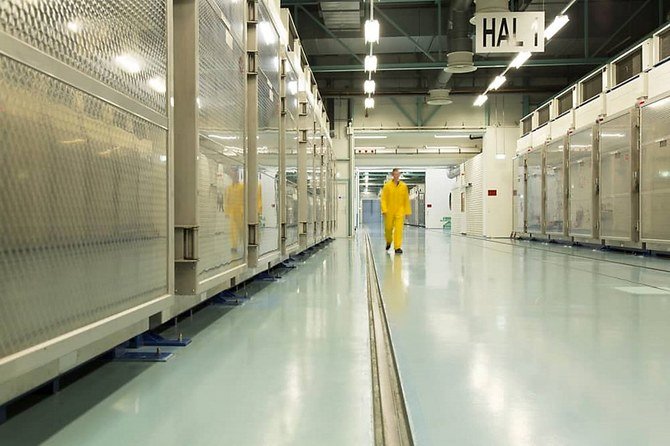
- ARAB NEWS
- 06 Jul 2025

The Iranian regime appears to have recently significantly shortened its nuclear breakout time — the amount of time it requires to produce enough weapons-grade uranium (WGU) for a single nuclear weapon. Tehran has achieved this through several steps in the last few months.
Last week, Iranian nuclear chief Ali Akbar Salehi defiantly declared that Iran has “enough” 20 percent enriched uranium. He added that the country is resuming uranium enrichment at 5 percent at the Fordow nuclear facility, injecting uranium gas into centrifuges, and operating 60 IR-6 advanced centrifuges. WGU is achieved at about 90 percent enrichment.
This marks a dangerous phase in Iran’s nuclear defiance, as it is now using a kind of prototype centrifuge that enriches uranium almost 50 times faster than what was allowed under the 2015 Joint Comprehensive Plan of Action (JCPOA), commonly known as the Iran nuclear deal.
Iran’s moves are a clear violation of the terms of the JCPOA, under which the Iranian leaders agreed to cease the enrichment of uranium at Fordow for 15 years and convert the facility into a scientific research center.
The previous three steps that Tehran took in violation of the nuclear deal included increasing its enriched uranium stockpile beyond the deal’s 300-kilogram limit; enriching uranium to levels beyond the cap of 3.67 percent; and activating 20 IR-4 and 20 IR-6 advanced centrifuges.
The Iranian leaders are also making an absurd claim that needs to be addressed: That its nuclear activities are solely for peaceful purposes. If there are indeed benign intentions behind the Islamic Republic’s nuclear program, why does it not follow the basic terms of the Non-Proliferation Treaty (NPT)? Iran has been a party to the NPT since 1970 but it has repeatedly failed to report its nuclear facilities, including the reactors at Natanz and Arak, to the International Atomic Energy Agency (IAEA).
If there are indeed benign intentions behind the Islamic Republic’s nuclear program, why does it not follow the basic terms of the Non-Proliferation Treaty (NPT)?
Dr. Majid Rafizadeh
In addition, why is the Iranian regime declining to answer the IAEA’s questions about revelations regarding a secret facility, which is reportedly located in the suburbs of Tehran? Two nonpartisan organizations based in Washington – the Institute for Science and International Security and the Foundation for the Defense of Democracies – last year released a detailed report on Iran’s clandestine nuclear activities at this site. And the IAEA’s inspectors were, in September, able to detect traces of radioactive uranium at the site.
Why does Tehran not permit international inspectors to examine its nuclear activities at the military site at Parchin? And why did Iran recently prevent a UN inspector from entering the Natanz nuclear site?
Furthermore, why did the Iranian regime place an anti-aircraft S-300 missile system at the Fordow site following the nuclear agreement? Finally, why doesn’t the Iranian regime adequately address reports about its efforts to obtain illegal nuclear technology and equipment? Germany’s domestic intelligence agency, the Federal Office for the Protection of the Constitution, revealed in its annual report for 2016 that the Iranian government had pursued a “clandestine” path to obtain illicit nuclear technology and equipment from German companies “at what is, even by international standards, a quantitatively high level.”
In other words, the detection of uranium at Iran’s clandestine nuclear facility in Tehran, Iran’s reluctance to answer simple questions about its facilities, and nonpartisan evidence about Iran’s continuing nuclear activities all point to the suspicion that Tehran’s nuclear program was never designed for peaceful purposes, as the Iranian leaders claim.
After four years, it has also become clear that the JCPOA was nothing more than a pro-mullah agreement that provided Iran’s ruling clerics with billions of dollars to pursue their hegemonic ambitions and pro-terror activities, while simultaneously providing cover for Tehran to pursue its nuclear ambitions.
Iran’s two-decades-old nuclear file demonstrates the ruling mullahs’ interest in obtaining, and active pursuit of, WGU for nuclear weapons.
Dr. Majid Rafizadeh is a Harvard-educated Iranian-American political scientist. He is a leading expert on Iran and US foreign policy, a businessman and president of the International American Council. Twitter: @Dr_Rafizadeh.